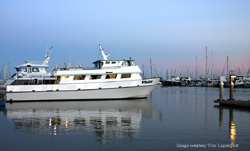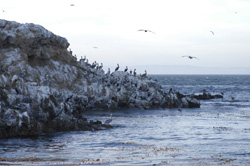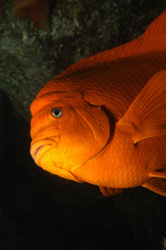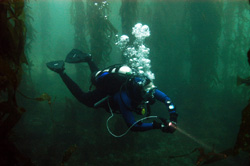| Prologue
California dive boats
generally can not be described as luxurious, and the sturdy boats
of the Truth Aquatics fleet out of Santa Barbara are no different.
But while they may not offer fine dining or turndown service in
private cabins with ensuite facilities, they do offer fantastic,
no-frills, dive 'til you drop, hard-core diving in California’s
untamed Northern Channel Islands.
I first ventured south
to dive California from my native Canadian Great Wet North on
September 11, 2002, after being lured into making the trip by
several Rodale’s D2D dive community board regulars. After
much kibbutzing on the board, I made the commitment to pack my
drysuit and join an internet dive community trip that was planning
to take in some of arguably the best diving that California has
to offer.
I need to add that
I had never actually “met” any of these divers in
person, but somehow I felt that I “knew” them through
their bulletin board personae, and figured that anyone who loves
bracing, cold water diving as much as I do can’t be all
bad.
I recollect that there
were not many souls eager to fly on that first anniversary of
the terrible events in New York and Washington, allowing me to
breeze through what would normally be long and arduous security
line ups. I also remember being summarily booted out of Terminal
1 in Los Angeles to be left sitting unceremoniously on my suitcase
on the curb for several hours to await my tardy ride up to Santa
Barbara, due to heightened security measures that day.
That initial trip to
California in 2002 was a real eye opener for me. Even after much
traveling for diving over several years, it was my first liveaboard
dive experience.
All seemed quite benign
as the 24 divers on the trip climbed aboard late in the evening
to unload and set up gear for the three day cruise, swill a couple
of beers as we all got to know each other, and then hit the dorm
style bunks below decks in preparation for the 4 a.m. departure
from Santa Barbara for the northern Channel Islands.
It was a rude awakening
to find myself levitating above my bunk in the bow in the wee
hours, as we cleared the harbour breakwater and headed out into
6 foot swells. The waves did not let up much over the ensuing
days, and being a neophyte on liveaboards, I had not clued into
pharmaceuticals such as the Scopalamine transdermal patch which
would have alleviated my mal-de-mer and allowed me to keep on
diving without ill effects. As it was, I toughed it out during
the day, finding relief by being under water, and then took a
motion sickness med in the evening that helped knock me out until
the next day. Even with the perpetual motion sickness I experienced
throughout the trip, I was hooked on this whole liveaboard thing,
and I knew that I would return to dive the Channel Islands with
this great group of divers again.
The
Truth Is Out There: Diving in California's Northern Channel Islands
Click on any image
go see a larger version
 |
In
September 2004, the opportunity arose for me to make a second
trip to the islands. This time, armed with a Scopolamine
patch, a new cozy drysuit, and a housed Nikon D100, I was
ready to do it right.
I
missed what has become an annual Rodale's D2D California
Truth trip in 2003 as I was diving in the Galapagos. That
year there were some last minute troubles with the boat,
and so as compensation, the group was offered an upgrade
from the Truth to the Vision, a much larger vessel, for
the September 2004 trip. A roomier salon, dive deck and
bunkroom made the trip all the more enjoyable for the 28
divers who signed on.
|
The
overnight trip out to the islands was much easier this time –
one to two foot swells and a bunk midships meant that I actually
managed to bag some sleep. Waking up well-rested to a hot breakfast
and a beautiful day in Southern California set the pace for what
was going to be a fantastic few days of diving.
When I did
the trip in 2002, we had typical coastal California early fall
foggy skies and cool air and water temperatures, which meant less
plankton, which in turn meant very good visibility. This time
we experienced clear blue skies, warmer air and water temperatures,
more plankton and so poor to moderate visibility underwater.
Life on a
liveaboard becomes a happy blur of eat, dive and sleep. Five dives
a day are there for the taking for the hardy, but unfortunately
Nitrox is not part of the offering. Water temperatures range from
the high 40's in the most northerly islands to mid-60's farther
south.
There is no
hand-holding when it comes to diving in California. A quick briefing
is given and then the gate is opened and divers hit the pool.
There are no divemasters in the water giving guided tours. Solo
diving is perfectly acceptable and divers are free to dive their
computers as they see fit. It is a refreshing change from highly
controlled, cattleboat, lowest common denominator diving that
seems to be so prevalent in the Caribbean. Solid accounting takes
place after each dive to ensure that all divers are on board before
the boat is moved to the next site. All in all, it runs suprisingly
smoothly for a boat with 28 divers on board.
There
is a wildness to the northern Channel Islands that seems
incongruous with the over-populated smog enveloped cities
just a few miles across the ocean. Stark, mostly uninhabited
and teeming with a diverse and colourful array of sea life,
the islands seem out of time. These islands are not just
beautiful from below. It is not at all unusual to see dolphins
cavorting off the bow, or pelicans or frigates flying high
above.
It
is unusual to see other evidence of humanity.
We saw
very few other vessels on our three day trip - just a few
intrepid sailboats and a boatload of daytrippers who were
kayaking at the marine sanctuary at Anacapa Island. |
 |
 |
Seamounts, canyons, sea lion rookeries and life-encrusted
gently sloping reefs make up the terrain in this part of
the world, with a significant swing in biodiversity between
the most northerly islands, which are thick with colourful
anemones (reminiscent of British Columbia diving), to the
more southerly islands which feature, amongst other wonders,
the surreal garibaldi - a large orange fish that is a member
of the damsel family.
This
fish is very challenging to photograph; it flits territorially
around the reef, warily checking out divers as it scoots
in around kelp fronds and rocky formations.
However,
I could spend an entire dive trying to get a good shot of
one of these dudes; they are completely cartoonish and are
very brightly coloured on an otherwise very muted background.
Other
highlights of this trip were the sighting of a spotted
seal, a baby octopus and
several thousand brittle stars that paved the ocean floor
on the way to the sea lion colony at Anacapa Island.
|
One
of the special features of California diving, at least for
me, is the fantastic poliferation of kelp that grow up from
the sea floor, stretching their ethereal limbs to the sky.
We have
kelp up here in British Columbia, where the scrawnier bull
kelp prevails, but nothing compares to the thick forests
on the California coast where kelp stalks grow in labyrinthine
forests of green and gold. |
 |
 |
However,
beware the kelp monster. This beautiful stuff presents a
very real entanglement hazard.
Snags
on fin clips, gauges, camera arms and first stages can put
a serious stranglehold on unwary divers.
The
number one rule is to go slowly, and if entangled, stop
immediately and calmly disengage the offending plant. Spinning
and fighting will do nothing but cause further chaos. |
And then there are the California Sea
Lions.
Other
than the incredible experience of swimming alongside a 40
ft whaleshark, I don't think I have surpassed the thrill
of several dives with sea lions, both in California and
in the Sea of Cortez in Mexico.
Puppy
dogs of the sea is the only way to describe these animals
- the juveniles are playful, naughty (they have been known
to nip at fins and snorkels, and occasionally, divers themselves)
and are highly interactive with humans. It's a thrill a
second as you watch them barrel roll, swoop and race to
the surface for a breath of fresh air before returning to
play with their visitors. |
 |
California
diving is not for the weak of heart, nor for the non-adventurous
lover of tepid, embryonic blue water. The Landlord (local slang
for Great White Shark) prowls the seas here, with sea lion rookies
being a target-rich environment for them. The Channel Islands
are completely exposed - next stop is Japan. That can make for
very rough seas and challenging, surgy dive conditions. The water
is cold, and the visibility at times extremely murky.
But, between
the majestic kelp forests and the garibaldis, the colourful
nudibranchs and the funky sea hares,
it is unique in all of the diving I have done thus far. Doing
the diving off a rough and tumble liveaboard, with newfound friends,
couldn't be better. I have gone on to travel with many of these
people in other locations, including inviting several of them
to come up to British Columbia so that I can show off our even
colder water cornucopia of life.
And that initial
leap into the unknown of the internet dive community has led me
to join several group trips, with people from all sorts of places
and all walks of life.
It is a small
world, after all.
|

